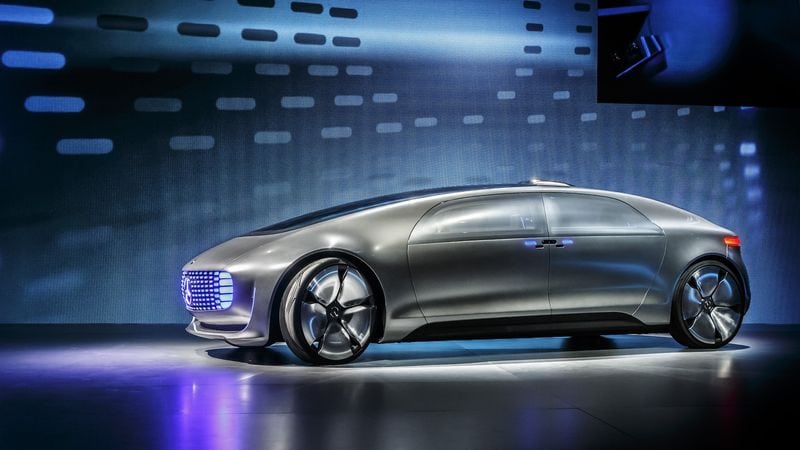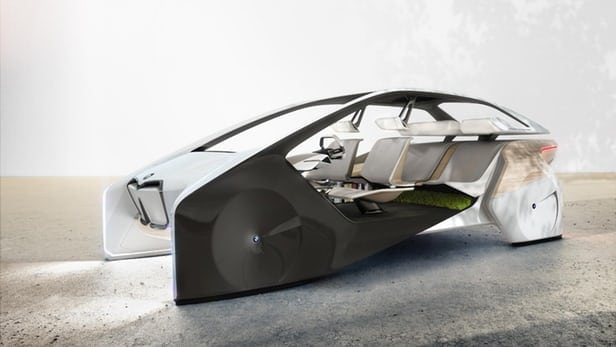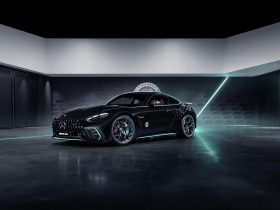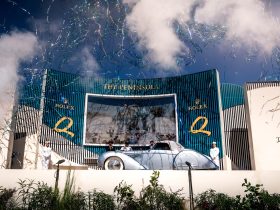In a world premiere, Mercedes-Benz unveiled the self-driving fuel cell hybrid electric F 015 Luxury in Motion concept at the CES. In addition to its autonomous driving capability, a key aspect of the research vehicle is the continuous exchange of information between vehicle, passengers, and the outside world.
The single most important luxury goods of the 21st century are private space and time. Autonomously driving cars by Mercedes-Benz shall offer exactly that. With the F 015 Luxury in Motion, this revolutionary concept of mobility becomes tangible for the first time. -Dr. Dieter Zetsche, Chairman of Daimler AG and Head of Mercedes-Benz Cars
The drive system is based on the pioneering F-CELL PLUG-IN HYBRID system seen in the F 125! research vehicle from 2011 (earlier post), and combines on-board generation of electricity with an exceptionally powerful and compact high-voltage battery. The pressure tank made from CFRP is designed to store the hydrogen.
The stack in the F 125!, which is further improved with respect to performance, consumption and practical suitability, provides the power for four electric motors installed near the wheels. The modular e4MATIC system, which also uses improved drive components from the SLS AMG E-CELL, . This accelerates the F 125! to 100 km/h in 4.9 seconds, with a top speed of 220 km/h (137 mph).
New materials and structures were used to develop the highly efficient “Smart Body Structure (SBS)” of the F 015. By combining carbon-fiber-reinforced plastic (CFRP), aluminum and high-strength steels in a way that matches the varying requirements exactly, the lightweight engineering experts were able to make the bodyshell 40% lighter compared with today’s production vehicles.
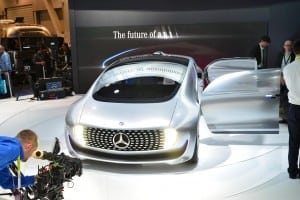 Another key element of the body design concept is the innovative saloon-door-style door system featuring rear-hinged rear doors. The front and rear doors can be opened and closed independently of one another. With an opening angle of 90 degrees for all doors, the spacious interior can be easily and comfortably accessed on both sides. B-pillars were not needed.
Another key element of the body design concept is the innovative saloon-door-style door system featuring rear-hinged rear doors. The front and rear doors can be opened and closed independently of one another. With an opening angle of 90 degrees for all doors, the spacious interior can be easily and comfortably accessed on both sides. B-pillars were not needed.
A sturdy interconnected system with mechanical locking elements ensures exemplary safety standards. These elements securely interlock the front and rear doors when they are closed at the same time as fixing them firmly to the roof frame and side skirts. The resulting composite load path allows an extremely high amount of energy to be absorbed in the event of frontal or side impact, with minimal intrusion into the passenger compartment.
The doors themselves have a crucial role to play in the vehicle’s passive safety concept. The crash-responsive beltlines underneath the side windows are vital here. The PRE-SAFE Structure, previously unveiled on the ESF 2009 Experimental Safety Vehicle and now further enhanced, offers maximum safety while taking up minimum space: in a side-on collision, these bodywork elements “inflate” in an instant, just like an airbag, allowing them to absorb as much impact energy as possible.
The bodyshell of the F 015 Luxury in Motion was designed to allow the impact-protected integration of the electric drive system with fuel cell.
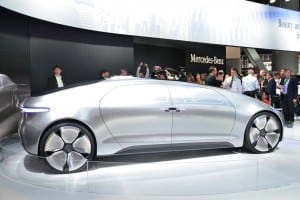 As a foundation for creating the F 015 Luxury in Motion, experts from all areas of Mercedes-Benz developed a future scenario entitled “City of the Future 2030+”, which considered many aspects of mobile living.
As a foundation for creating the F 015 Luxury in Motion, experts from all areas of Mercedes-Benz developed a future scenario entitled “City of the Future 2030+”, which considered many aspects of mobile living.
The greater the advance of urbanization, the greater is the desire of the individual to be able to retreat to a private sphere. Autonomous driving will become a given, Mercedes said. As drivers are relieved of work and stress in situations in which driving is not enjoyable, the time gained while in their car takes on a whole new quality. Time and space will become the luxury of the future.
New technologies and forms of communication open up numerous new possibilities for interaction, both between the vehicle and its passengers and between the vehicle and other road users.
Autonomous cars also open up new possibilities for urban infrastructure design. Following the example of today’s low-emission zones in city centers, special “safety zones” that are only accessible to autonomous vehicles could be created. Urban space would be regained by autonomous vehicles parking themselves on the periphery.
In the shared space of the future, humans and machines share the roads. The “car-friendly city” is transformed increasingly into the “people-friendly city” without any loss of individual freedom. The divide between residential, recreational and traffic areas therefore melts away. The result is superior quality of life for all urban dwellers.
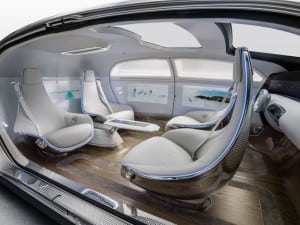 The F 015 has unusual proportions (length/width/height: 5220/2018/1524 millimeters), with a seamless, monolithic exterior and large LED light modules at the front and rear. A range of different lighting functions can be provided through these LED fields. At the same time, the vehicle communicates and interacts with the outside world by means of the LED fields. These LED fields show for example, if the F 015 is driving autonomously (blue) or is controlled manually (white).
The F 015 has unusual proportions (length/width/height: 5220/2018/1524 millimeters), with a seamless, monolithic exterior and large LED light modules at the front and rear. A range of different lighting functions can be provided through these LED fields. At the same time, the vehicle communicates and interacts with the outside world by means of the LED fields. These LED fields show for example, if the F 015 is driving autonomously (blue) or is controlled manually (white).
The F 015 Luxury in Motion’s unusually large wheelbase of 3610 millimeters in combination with its short overhangs show that the design focus was on providing the maximum possible space for the passengers.
The pivotal feature of the innovative interior concept is the variable seating system, with four rotating lounge chairs that allow a face-to-face seat configuration. All four passengers can use their time aboard to work, to relax or to communicate. In order to make getting in and out of the car easier, the electrically powered seats also swing outwards by 30 degrees as soon as the doors are opened.
The structure of the high-strength bodyshell of the F 015 Luxury in Motion provides the basis for the door concept that makes getting in and out especially easy, and for the communication-oriented seating featuring four lounge chairs in a face-to-face arrangement.
Six display screens are integrated into the instrument panel and the rear and side panels, which turn the interior of the F 015 Luxury in Motion into a digital arena. Passengers can interact intuitively with the connected vehicle through gestures, eye-tracking or by touching the high-resolution screens.


